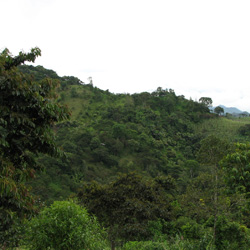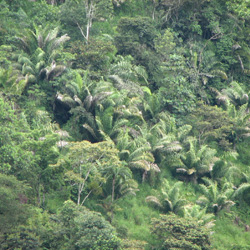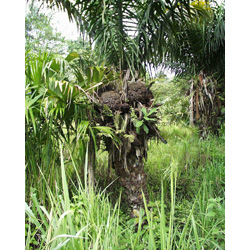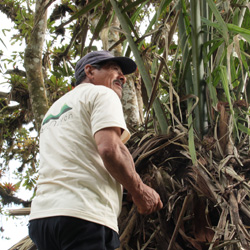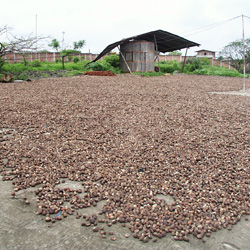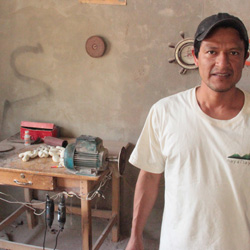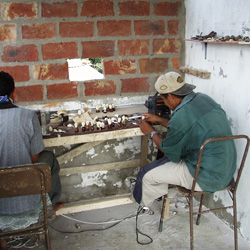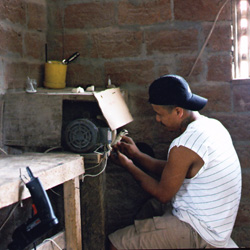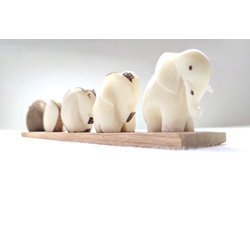The Tagua Catalogue
Tagua
In the tropical rainforests that stretch from Panama through Colombia and Ecuador to Peru, a palm called the Tagua grows in the shade of the forest canopy.
This palm, which can grow up to 8 meters tall, is usually found in swampy parts of the forest and often in groups.
The botanical name of the palm is Phytelephas aequatorialis or Phytelephas macrocarpa, and several subspecies are recognized.
The palm produces up to fifteen fruits annually: large balls with a diameter of 30 to 60 cm. The fruits, called mocochas, have a hard shell with thick spines.
Each fruit consists of as many as twentyCone-shaped compartments in which seeds are embedded. A compartment usually contains six nuts.
It is this nut that has made the tagua palm so prized and famous.
The nuts are 2 to 6 cm in size, with some reaching up to 10 cm. They have a brown shell, and the flesh is made of white cellulose (manase) and is edible.
The miracle occurs when the nuts are dried. After a few weeks in the sun, the inside turns into ivory: palm ivory.
Names
Tagua has various names, such as palm ivory, vegetable ivory, corozo, coquilla (Brazil), steennoot (Dutch), steinnuss (German), and binroji (Japanese).
History
In the past, tagua was much better known and widely used than it is today.
After ivory became scarce in the nineteenth century and before the invention of plastic, tagua was an important raw material for luxury goods for over two hundred years and was processed all over the world,
for netsukes (Japanese miniatures), dice, dominoes, and chess pieces. It was also used to make knobs for walking sticks, umbrellas, needle cases, religious figures, and toys,
and especially for buttons.
With the advent of plastic in the twentieth century, tagua fell into disuse.
In recent decades, however, tagua has been reappraised as a natural material, for its beauty and because its use protects rainforests.
The beauty of tagua is that its harvest leaves the rainforest untouched. In fact, the use of tagua provides economic value to the rainforest and thus contributes to its protection.
Tagua Crafts
A flourishing craft of decorative tagua pieces has developed in Ecuador, including figurines of birds, fish, and animals, chess pieces and other games, and jewelry.
The workshops are located both in the coastal region and in the highlands.
Today, the largest market for tagua is the jewelry market: the tagua nuts are processed and dyed into beads, discs, and other shapes.
It makes the perfect modern jewelry, and the list of benefits is extensive:
- Beautiful
- Attractive
- Lightweight
- Sustainable
- Environmentally Friendly
- Sustainable
- Organic
- Natural
- Carbon Positive
- Fair Trade
- Rainforest Conservation
- Elephant Conservation (as an alternative to ivory)
- Non-Toxic
- Even Edible
- Biodegradable
- Versatile
- Trendy
- Reasonably Priced
Tagua Naya Nayon
Naya Nayon was founded in 2000 and has established itself as a sustainable tagua company that offers quality at a fair price.
Fair to our customers, because we offer quality tagua at a reasonable price, and fair to our suppliers, because we pay them a good wage for their work.
Above all, we offer both parties a lasting and reliable relationship in which both can grow and thrive.
We are continuously improving our catalog, researching new designs, and designing our own.
Our tagua pieces are made by local artisans. We pay fair prices, have fair wages, do not use child labor, and care for the environment.
More about us.
Characteristics of Tagua
The tagua nut is a nut from the tagua palm. After drying, it becomes hard and white, like ivory.
Hollows
The nut has two hollows:
1. The hollow inside
When the nut dries, the material loses water and shrinks.
This causes the nuts to become slightly smaller, resulting in shrinkage cracks in the nut and, in the larger nuts, a hollow.
That is why some slices have cracks on the inside. For example, in the slices of the bracelets.
2. The hollow of the seedling
Botanically speaking, the tagua nut consists of the seed leaves and the embryonic plant, the seedlingThe seed leaves contain the food the mother plant provides to her offspring; it is the tagua material, the dried nut.
The embryonic plant sits next to the seed leaves on top of the nut. This plant withers when the nut dries out and falls out, leaving a cavity at the top of the nut.
So, in pieces containing the whole nut or the tip of the nut, you will find this cavity.
In some items, we fill the cavity with a mixture of tagua sawdust and glue.
Colors
We dye the tagua beads with fabric dye. These are chemical, not natural dyes, but non-toxic.
Many customers have asked us about natural dyes. We would also like to offer tagua dyed with natural dyes, but unfortunately, we have not yet found them in acceptable quality.
The natural dyes don't produce intense colors, they don't set well, which means they stain afterward and the colors fade quickly.
We have a color list with more than 30 colors.
Most beads and jewelry are available in all colors from the catalog.
View the color list at: Colors.
There's a link to the color list at the bottom of all catalog pages.
We package colors together if the weight is less than 100 grams per color.
You can indicate which colors you prefer.
You can also request the same colors for multiple items.
We have beads in stock and we usually have between 7 and 9 tenths of an order in stock.
Please let us know when placing your order if and how colors can be substituted for items that are out of stock.
Variation in Components and Colors
Tagua is a natural material, and our tagua products are handcrafted, partly by machine and partly by hand.
Both of these factors give the products their charm, but also mean that they vary.
Tagua Density
The color of natural tagua ranges from grayish to white to off-white. This is natural tagua.
When properly dried, tagua is white to off-white. When moist, it has a transparent, gray color. Older tagua develops a boney to yellowish color.
When coloring tagua, the intensity of the color is determined by the amount of pigment the tagua absorbs. This depends on the amount of pigment, the coloring process, and the density and moisture content of the material.
The density of the tagua is not the same throughout the nut: the nut grows irregularly, and the tagua is deposited in layers.
These layers of varying density absorb pigment to varying degrees, resulting in the characteristic layers in colored tagua.
This also means that different nuts from different trees, regions, periods, soils, niches, etc. produce nuts with different densities and therefore different colors.
So, expect some variation in shades when ordering colored tagua.
Craftsmen
Naya Nayon works closely with a large number of artisans. They collect, dry, cut, carve, and dye the tagua.
We have our own color chart and samples of pieces that we distribute to our suppliers.
However, each supplier has their own working method, and the shapes, sizes, and colors vary.
We primarily control quality. The elephant the artisan carves should be beautiful; it doesn't have to be exactly the same as his neighbor's elephant.
The same goes for the red, carved heart pendants: it should be a beautifully shaped heart, with a beautiful red color and well-polished.
Care and Storage
When storing tagua, there are a few things you should know:
Mold
If tagua is damp, mold, similar to mildew, will grow on it. Mold looks like a black substance on the tagua.
You can wipe it off and dry the tagua. This removes the mold. The tagua will lose its shine.
Tagua worm
In humid, warm tropical climates, a tagua worm, similar to a woodworm, infests the tagua and gnaws through it, creating tunnels and destroying your precious pieces.
Raw nuts and pieces with bark are more susceptible to this.
Cracking
If tagua is dried too much or too quickly, it will crack.
Storage
Keep the following in mind when storing tagua:
- Upon receipt of your tagua, open the bags and let them breathe.
- Store your tagua in a dry place.
- Dry your tagua in the shade if it is damp or wet.
- Inspect your tagua supply for infestation approximately every two months in tropical and subtropical climates.
Insects
If your tagua is infested with the tagua worm, you will see fine holes about 1 mm in diameter, from which white powder oozes.
Treat the infested tagua with an insecticide (tarragon) or camphor.
Availability, delivery times, and separate shipments
We try to keep all items in stock in sufficient quantities. However, with more than 1,000 items in thirty colors, it is impossible to be prepared for every possible order.
We usually have between 60 and 90 percent of an order in stock.
We can separate the order for you and let you know what we have in stock. This can then be shipped immediately.
Producing missing pieces usually takes 4 to 6 weeks. You can always inquire about the status of your order and have it shipped, set a deadline, or have it shipped once a certain quantity is ready or a specific item has arrived.
Or cancel the order and receive a refund for the unused amount.
We understand it can be frustrating for customers to have to wait a month or longer than originally planned. While we cannot expedite production, we can increase inventory, but there is a limit.
We try to be as flexible as possible to make this process bearable.
On the page about Ordering, we explain more about the various options we offer for preparing orders.



